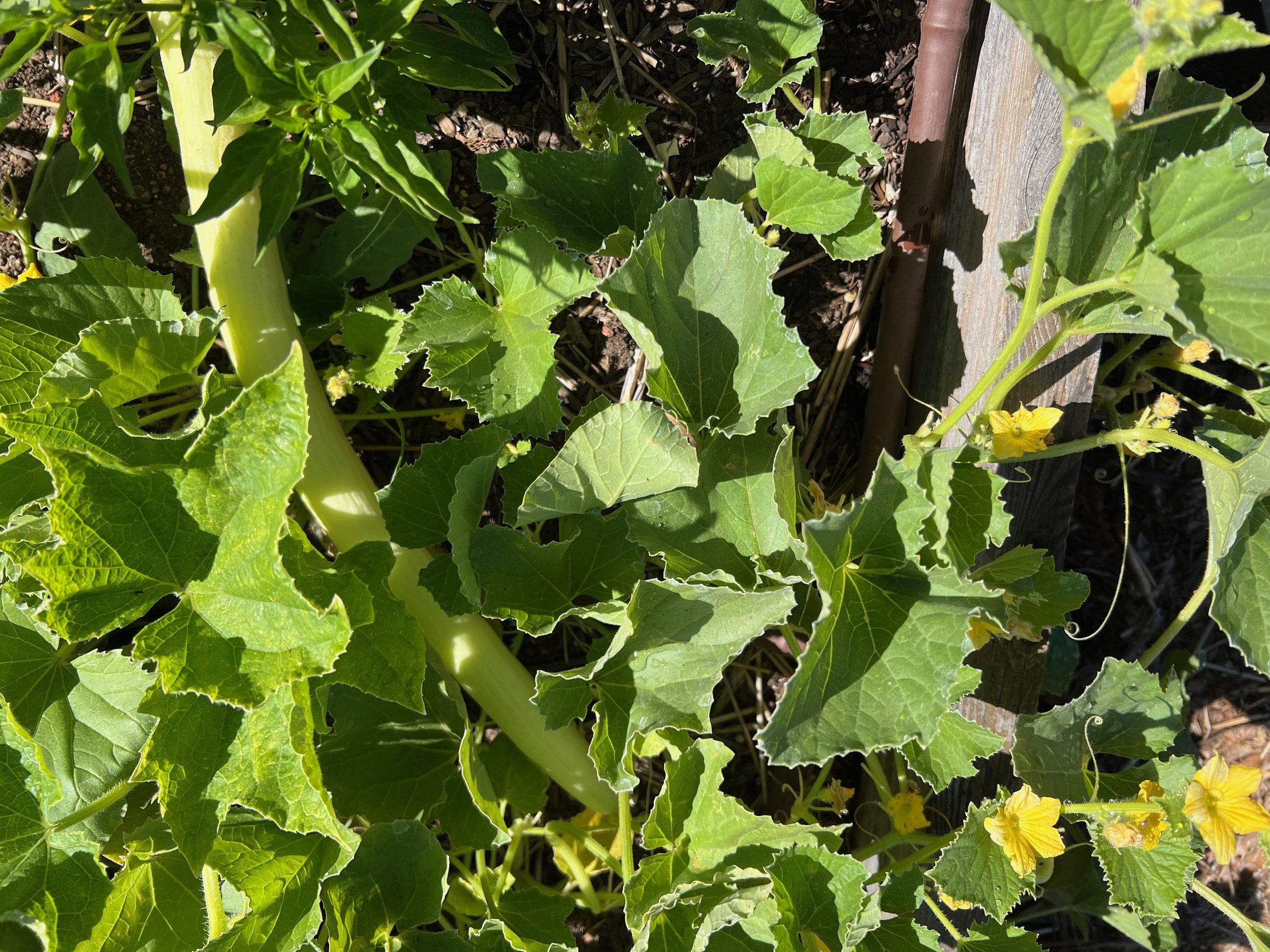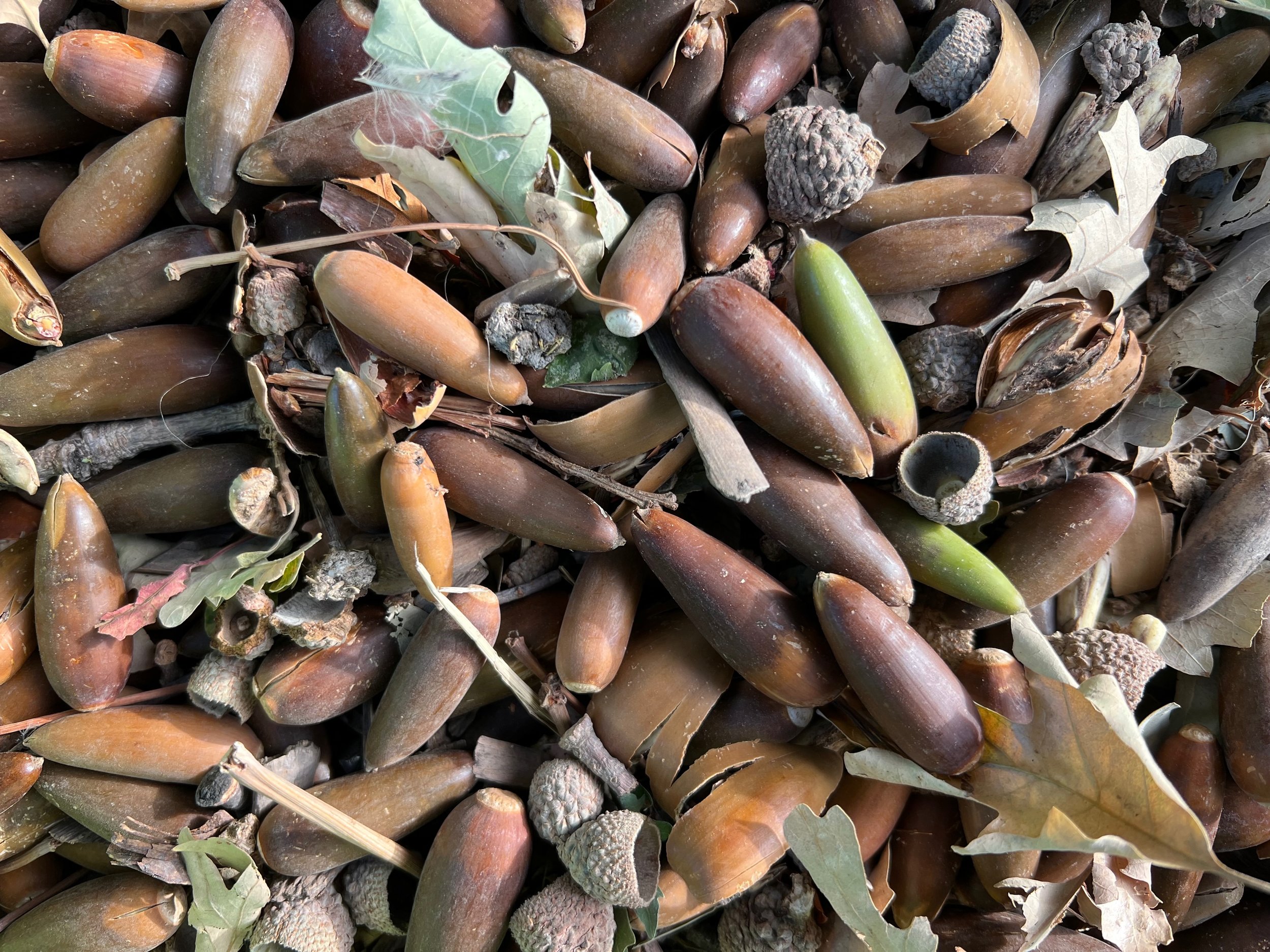When we installed our top bar bee hive (made by my father) ten years ago, we picked a nice site in a place that got morning sun and afternoon shade, was sheltered from wind, and mostly hidden to passersby. We also leveled the site before putting the sawhorses and hive in place, resting them on concrete blocks to keep the legs up off the soil.
Over the years, the earth has settled and shifted. This is due to many factors: One, this is earthquake country; two, we have 100% clay soil which swells and shrinks during wet or dry periods (and in California, it’s either very wet or very dry, not much in between); and three, I’ve been adding mulch in that area for years, which has probably worked its way under the legs somehow. So it’s not a surprise that our hive began to list.
For a long time, we would ‘solve’ this problem by shimming up a side (you can see our first shim on the left). That was an easy ‘fix,’ and would hold for a while before needing to shim it up on the other side. Sometimes I would even put an especially large piece of bark under one of the sawhorse legs. It wasn’t an exact science, but the thought of moving the whole thing and re-doing the area was daunting.
But finally, this fall, the hive started to lean in earnest. This was worrying, not least because if it started to gain some momentum, the whole thing could have just slid off the sawhorses, which would have been a colossal mess and would probably really freak out the bees (and make them very aggressive and/or want to leave), or even harm them. Was it leaning over that far? Probably not, probably I’m exaggerating. But what was definitely happening was that our bees started to beard every night, even on cool nights.
Bearding is when bees hang out at the front of the hive, on the ‘front porch’ so to speak, and make a big hanging mass of bodies which looks like a beard on the hive. This usually only happens when it’s super hot out, and the bees can’t keep the hive at the 93 degrees they prefer. They remove some heat from the hive by removing bodies. Smart, right? But bees can also beard when they run out of room, or if there is poor ventilation in the hive.
See the picture at the top of this post? That’s a beautiful comb, from our top bar hive. Since top bars don’t use frames, like Langstroth hives, the bees build on a bar which rests on the top (hence the name). What this allows is for the bees to build the way they like. And bees like to build their comb in catenary curves. When the hive is level, the comb perfectly fits the shape of the hive box, allowing for something called ‘bee space,’ which means there’s just enough room at the edges and bottom for the bees to move freely around the colony.
Gravity plays a big role in how bees build comb; they naturally build in line with the pull of gravity. When a hive is level, they create an ideal comb. When a hive isn’t level, the bees are confused. They build asymmetrically or in a funky shape. The comb can encroach on other combs, and create a mess. It can also lean with the hive, and honey is heavy, so the comb can slide off the top bar and create an enormous sticky pile of wax, honey, and bees at the bottom of the hive.
My working theory, while viewing the leaning hive, and the constant bearding, and after hearing how Tom, when working in the hive, found lots of comb stuck to the sides and bottom (so the bees weren’t building comb correctly), was that the unevenness of the hive was past the point where a shim would help. We just needed to redo the entire area. This was a bummer, because it meant we had to move the hive.
Just like there’s an ideal time to work inside a hive (sunny warm afternoons, when a good portion of the bees are out foraging), there’s an ideal time to move a hive, and that time is never. But, second best is when it’s dark and the bees are tucked in for the night. So, since I’m not allowed to work anywhere near the hive due to my allergies, we recruited my dad to help.
Mom and Dad came over for dinner, and once it was dark, Tom and Dad went out to the hive and discussed the operation. Tom brought out our other sawhorses and set them nearby. They both made sure to cover arms and legs securely to avoid stings. Mom went out with a flashlight to help light the scene. And then there was nothing for it but to move it, that heavy hive, over to the side several feet. Job done! And no one stung, and no fuss from the bees at all.
I checked on them periodically the next day, and they were very confused. But by the second day, they had a new pattern of exiting/entering all figured out.
Then, the following weekend, the real work began. Tom started by removing eight inches of mulch and leaves until he found bare ground. Then he bought 240 pounds of construction-grade sand and wheelbarrowed it over to the space. Wet, level, wet again, level again, rinse, repeat. Then he bought bigger concrete footings and set them in. Level, pound, level again, pound again, rinse, repeat. Finally the sawhorses went back on the blocks. And then, my dad had to be pressed into service for the second time (will work for cookies!) and helped move the hive back in place in the dead of night. And voila! A newly leveled hive.
The bees had absolutely no confusion the day after moving back, which was interesting. They must have good memories. Or deep instincts that reminded them that they oriented to this position originally.
So, that oughta do us for another ten years. Unless the big one comes, and then we’ll have other things to worry about anyway.




















